The Basics of Pond Care by Clifford Woods 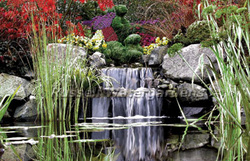 Proper pond care is comparatively straightforward on the condition that the pond is well-made in advance of putting fish into it as well as being properly maintained when in operation.
With both ponds and pools, you need to make sure that the proper water levels are taken care of, either by filling it in excess for the duration of hot weather seasons or depleting it in the course of rainier periods. This will prevent undue weathering of exposed areas of pond liner or erosion of banks if flooding occurs.
Splits in cement or holes in liners can often be fixed, however it is quite time intensive and certainly an issue worthy of avoidance. Appropriately blended cement should never fracture even during extreme climate changes. Most shredding in liners is a result of inappropriate selection of the proper fish pond liner in advance of installation, additional reasons are the feared visits from the otter, heron, raccoon, and other similar animals whose razor-sharp claws can effortlessly pierce weaker pond liners.
Fish Care
Assuming that your pond water is properly oxygenated and fish aren't over-fed, the fish should continue to be healthy. However, if you do observe fish behaving out of character or floating around too lethargically then in that case it is advisable to contact your local pond fish authorities. Protrusions or skin lesions are evident indications of stressed fish and really should be dealt with the instant it is observed.
Once again, a quick call to your own personal local fish pond treatment company to ask for a precise analysis and what therapy should be done is usually adequate to save your pond fish.
Seasonal Care
The later part of the fall and winter are generally not the ideal times of year to thoroughly clean your pond, as you will most likely disrupt all of the vegetation and fish attempting to adapt to the winter season. A few plants send down sprouts to the bottom level of the pond exactly where they sit until the weather conditions become a bit warmer.
The perfect time for an effective clean up is in early spring, following the last frosts, whenever pond life is back to being lively and the fish start to eat actively. Normally it is not recommended to completely drain and clean out ponds as this tends to get rid of the friendly microorganisms as well.
Improve Appearance and Protect Your Pond
To enhance the visual appeal of the pond as well as to protect against disease, get rid of any decaying plant life from the water and small vegetation following the initial couple of frosts at the beginning of fall, excessive floating vegetation that appears lifeless also needs to be taken out with a net or rake.
Fish during this period aren't going to be feeding and will essentially survive on their very own body fats for the rest of the winter season. Be sure you provide them with sufficient protection by means of ledges, rocks, or extremely deep water where they are able to hide securely.
Algae
Green unclean water is a frequent issue with more compact ponds. A small amount of algae exists in all water; having said that, in lengthier intervals of sunlight even an ideal equilibrium of fish and plants is just not sufficient for complete avoidance and the water can becomes a livid green color. In tiny still-water garden ponds this can be prevented with the setup of a purification unit such as UV sterilizers.
The UV light can eliminates algae cells, while the filtration system gets rid of its inactive organic matter well before it can lead to more complications. One particular method for eliminating algae would be to use an algaecide abundant with beneficial microorganisms.
A probiotics solution may be helpful in getting rid of algae completely as well as boost the overall health of the pond environment.

Algae: The Leading Cause of Fish Deaths in Ponds
by Clifford Woods 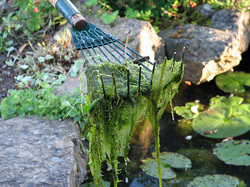
Fish pond algae are really a general name which represents all of the various types of algae, normally present in ponds. A few varieties of algae can actually be beneficial to the overall health of the pond while others types can be viewed as a real annoyance.
You will need to prevent as many algae blooms as you can in order to keep your fish and visual appealing pond vegetation alive. The most prevalent type is the floating green algae, like chlorella, euglena, and chlamydomonas varieties. They grow and reproduce quickly through cell division or spores.
Filamentous algae, also known as string algae, appear to be lengthy green noodles and have a hair-like visual aspect to them. The looks are a result of a combination of cells joined up end to end. Horse hair algae and blanket weed types like spirogyra, oedogonium, and cladophora are quite prevalent.
The Factors That Lead to Pond Algae Growth
The main three variables that enables pond algae to produce consists of: hot temperatures, vitamin abundant pond water, and crystal clear pond water that permits sunshine to pass through. A rise in temperatures speeds up both blanket weed and suspended green algae advancement.
How Various Algae Varieties Affect the Overall Health of the Fish Pond
Floating planktonic algae distribute at a speedy pace and can only be managed by ultraviolet illumination from a UV sterilizer. The UV spectrum splits the cell surfaces, resulting in the algae to collect together which in turn allows filters to easily remove the algae from the pond. An substantial amount of floating green algae can produce what is known as algae blooms. They could be devastating to pond fish as the blooms will at some point deprive the pond of oxygen thus killing off all underwater plants and fish life. 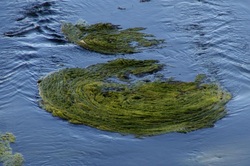 Why Too Much Algae is Harmful for Garden Ponds
Algae does not just make the pond seem unpleasant and overgrown, but in more severe situations, can actually cause the pond to smell foul. The rotting process of algae eats up oxygen from the pond water. This is especially harmful to the oxidizing bacteria and pond fish population, which both need oxygen to thrive.
Keep in mind that ammonia must be changed into nitrites by the oxidizing microorganisms. The oxidation procedure calls for vast volumes of oxygen to be able to take place. The rise in ammonia, which is additionally created by decaying algae matter, puts even more stress on the pond filtration system that houses the nitrifying microorganisms.
 How to Control Algae in Your Fish Pond
By far the most effective way of handling suspended planktonic algae is to make use of a UV clarifier or UV sterilizer. The ultraviolet spectrum eliminates the single-celled algae, resulting in it expiring and sticking to other deceased algal cells.
However, UV does not discriminate between good and bad microorganisms and will simply kill all of them. This is not really good for your fish. And not all algae are bad for a fish pond ; in fact, algae can be quite helpful to the pond because it supplies a way to obtain food for fish, presents shade from the sizzling sun, and offers as a shelter from king fishers, heron, along with various other birds.
Make an effort to cover a minimum of one third the surface area of the fish pond with plants, since they contend with algae cells for the accessible vitamins in the pond water.
Conduct regular cleaning by getting rid of string algae and blanket weed by using a garden rake.
It really is alright to have a bit of algae on pond surfaces, filtration systems, as well as other pond maintenance gear. The key is to keep it in check with a probiotics solution such as an organic algaecide created with beneficial microorganisms.
 Clifford Woods is the CEO of Effective Environmental Services
and Organic Environmental Technology.
We brew Beneficial Microorganisms that eat toxins and offer Naturally Organic Solutions.
Algae Management in Freshwater Aquariums
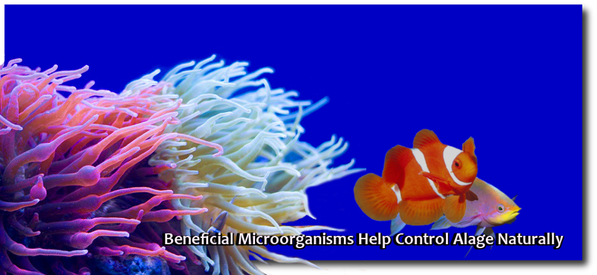 By Clifford WoodsAn aquarium tank can be quite the exceptional addition to a home or workplace. There isn't anything more relaxing than viewing fish swimming in harmony through the clear, dazzling tropical water. On the other hand, there is practically nothing more unpleasant than an aquarium tank abundant with algae.
Below are a handful of concerns and tips to assist with algae management.
Just about all fish displays contain algae. A small bit of it is not necessarily harmful, however if it isn't controlled algae can multiply quickly and take control of your freshwater tank which is extremely troublesome to clean, not to mention unhealthy for the fish.
Green algae are normal for most freshwater tank owners. The two main varieties, green dot and hair, can be time intensive in addition to difficult to eliminate from the aquarium.
These algae grow quickly in fish tanks that get an excess of sunshine. The darker types of algae, such as black brush, generally grow soon after the initial set-up of the tank.
The algae development in fish tanks that have already been set up for a longer period of time may be related to problems with the level of phosphate or nitrate in the water.
The growth of these algae may also linked to excessive amounts of light. In order to eliminate it from the fish tank, in most cases you have to clean the entire tank extensively, decrease light exposure, and also make certain that the water condition is at a suitable temperature.
Blue-green algae and red brush are two additional varieties of algae that may develop in a fish tank. The red brush variety generally has a tendency to form in fish tanks having higher pH levels. Blue-green algae are a slimier type which can be dangerous to both vegetation and fish in the tank.
One of the better processes to inhibit the development of numerous algae would be to manage lighting. For algae management, never place fish tanks close to windows and be sure to reduce the lighting to eight hours on a daily basis. Employing a lighting timer is a fantastic way to supply your fish tank with suitable quantities of light.
Much like your fish, algae have to consume to live. Algae develop best through taking in phosphorus, potassium, and nitrogen. You have the capability to significantly enhance algae management in freshwater fish tanks by making certain that your tank is not overwhelmed by fish waste products, excessive food, or rotting vegetation. Additionally, perform water adjustments regularly and use a properly measured filtration system.
Incorporating algae consuming agents to your aquarium would be a good option. Snails and algae-eating species of fish are able to assist in the management of algae within the tank.
You should be aware that snails can populate remarkably quickly, however with proper control including a snail and an algae-consuming species to a fish tank could very well be an excellent idea. Take note that when all of the algae are consumed, you are going to have to feed these fish with store-bought food.
It is not unusual for algae to start to re-populate within a clean fish tank during a time span of just three weeks. For regular algae regulation, be mindful with regards to overfeeding your fish, promptly remove any dead fish from the tank, be aware of the amount of light that the aquarium receives, and also use some type of filtering method.
Additionally, remove any obvious algae with a scrubber designed for this sort of cleanup. A really simple way to eradicate algae from a freshwater fish tank would be to apply a probiotic algaecide.This type of solution is perfectly safe for your fish and actually benefits the water in numerous ways due to the beneficial microorganisms contained with the product.

5 Key Factors of Green Pond Water
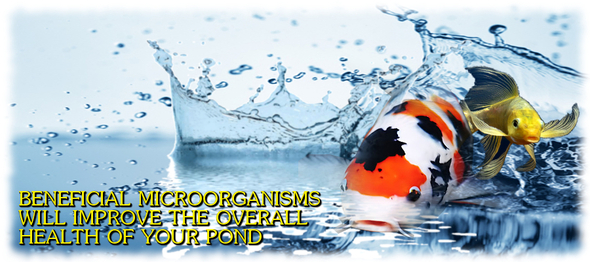 By Clifford Woods
Algae overgrowth can have disastrous consequences on the well-being of our ponds. Below are five factors that contribute the algae development and how it can be stopped.
#1: Excessive Fish
If this sounds like your situation, then immediately limit the volume of fish or add to the size of your organic filtration system. Keep in mind that fish grow in size and in quantity, therefore the scale your organic purification system which you believed might be the right size in the beginning, may not be the proper size for your pond now.
#2: Seasonal Changes
It is the start of the springtime or the later part of the fall when the pond encounters its largest change in the temperature of the water and biological bacteria development. If this is the situation, try to be calm and give your pond a few additional weeks.
Every single pond takes around four to six weeks in the beginning of the season to discover its new environmental equilibrium. When this occurs, the pond water will likely be green in appearance. In fact, you can count on it. At any time you increase the water level of your pond during the year, your pond is likely to turn green as well.
Simply add the most appropriate beneficial microorganism’s solution to provide your pond with good aeration and stay patient. Bear in mind, it will require several weeks, not just a couple of days. Never persistently drain and refill your pond because you will be consistently altering its ecological stability that it's striving to achieve – so give it a hand, be patient.
#3: Accumulation of Organic Matter
For those ponds that have more organic substances, like dead leaves, fish wastes, muck, sludge, and so forth, in them than the amount of beneficial microorganisms in your filtration system where beneficial microorganisms reside and flourish, you may either have to add to the size of your organic filter or increase the total quantity of beneficial microorganisms in your pond.
You can do this by one of two ways; basically increase the size of your filter of add more beneficial microorganism to your pond. You need to be incorporating beneficial microorganisms on a regular basis into your pond in any case.
#4: Too Much Water
Remain calm with your pond as it sets up its new environmental equilibrium. This often completes in about four to six weeks following the previous time you have added extra water. Whenever you add more water, you cause a difference in the pond which causes new algae to prosper and green water to occur. Simply have patience and increase the amount of beneficial microorganisms you add to your pond.
#5: Other Factors That Could Be Causing Algae and Killing the Beneficial Microorganisms in Your Pond
If you are introducing fresh water into your pond on a regular basis; quit doing so now. Allow the pond to find its new environmental stability. In the case that you are including beneficial microorganisms to it, but not disabling your UV clarifier or UV sterilizer, then make sure to turn it off no less than three to four days just prior to when you added the bacteria to ensure that the microorganisms have had an opportunity to attach themselves to the surface area within your pond or organic filter.
A few chemical compounds put into the pond can also be the reason for precisely what is wiping out your beneficial microorganisms. If that's the case, invest in an organic algaecide that contains beneficial microorganisms. You'll be killing two birds with one stone with such a solution as you will be eliminating algae as well as replenishing your pond with bacteria that will improve the pond's overall health.

How Does Phosphate Get Into A Pond
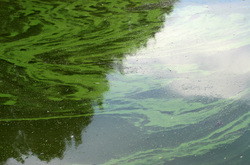 By Clifford Woods Ponds under attack from green water, poor coral growth, algae and cyanobacteria and are the things that are responsible for your dying fish. These are factors that generally leave aquarists frustrated, and most of them, are brought about by the presence of phosphate in water.What Are Phosphates?Phosphates are naturally occurring compounds, which commonly form in water bodies. This is largely due to a number of sources, the major one being water sources. Soil and salt mixes that are swept into the water as a result of rain or wind are a major responsible for phosphate infestation in ponds and these are usually harder to control than aquarium water. It’s important to note that phosphates are the active ingredients in fertilizers. That being said, salt mixes that could be found in rocks surrounding the pond may be the reason why your water is choking.How Can You Identify High Phosphate Levels?Identifying the signs of high phosphate levels can be obvious (if you know what to look for), or they might be a bit more subtle and hard to recognize but here a re a few:- The water color
- Predominant presence of nuisance algae
- Poor coral growth
Your water could indicate the presence of phosphates and if your pond is pea green, you need to think about phosphate testing. Nuisance algae predominance is also a good sign that your water is thriving with phosphates, since like already mentioned; it is the active ingredient in fertilizers and therefore, encourages growth of plants. And Algae of course is a plant.Types of algae to look out for are black hair algae and slime algae as well. You can also identify signs of poor marine, such as unhealthy corals and poor survival rates of invertebrates, such as shrimp and snails. There is several phosphate testing kits you can use to identify phosphate presence in your water.How to Remove PhosphateEliminating phosphates can be quite tricky and before you can conduct any elimination process, you need to first identify the cause. If you throw frozen foods into your ponds, this may the reason why there are high levels of the compound. You may want to consider rinsing foods before feeding your fish or simply avoiding frozen foods. The water that frozen foods are frozen in sometimes has high phosphate concentrations. Are there golf courses, farms or even fertilized gardens and lawns around your pond? If yes, run offs from the rain are washing these phosphates into your pond. Once you’ve identified (and hopefully eliminated) where the phosphate is coming from, you can start getting rid of what you already have. Water changes with phosphate-free water can help cut down on your levels but can take time before you see a noticeable difference. In saltwater aquariums, protein skimmers can help remove wastes and decrease the phosphate levels, and refugiums can be used in freshwater and saltwater tanks. There are various products in the market that can help you get rid of phosphates. These mediums act to absorb the compound or trap it for removal. When a phosphate remover is applied into the water, it basically traps the phosphates and immobilizes them, making them insoluble nutrients. Phosphates in ponds are harder to eliminate, since you cannot control what products people use in their lawns and farms. That said, you can control the levels by always ensuring that your pond is clean and using a phosphate remover often. With persistent testing and removal, your pond can have a good water quality for your fish and other marine species to thrive better.
Clifford Woods is the CEO of Effective Environmental Services and Organic Environmental Technology.
Find out more about pond care at http://www.effens.com
We brew Beneficial Microorganisms that eat toxins in the environment and offer Environmentally Friendly products.
What is Phosphate?
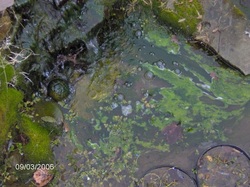 By Clifford Woods
Phosphates, which contain phosphorus, are essential nutrients that contribute to the growth and metabolic reactions of all animals and plants. The quantity of phosphorus can either increase or limit growth. Since it is essential to the growth of plants and animals, an imbalance in the amount of the natural growth of phosphorus can produce harmful changes to the environment. This is when it becomes a job for a phosphate remover to handle.
Contributing Factors In Phosphates Overgrowth
The internal contributor in the growth of the presence of phosphates in your fish pond is from the mineralization of dead matter, such as plants, uneaten food, feces, fish slime, bacteria, etc. The rotting food particles or dead plant materials settle either within the filter or on the substrate. Vacuuming the gravel or rinsing filter materials every time you change the water in your pond or tank will substantially decrease the potential accumulation of phosphate deposits. The probable external sources, on the other hand, are additives such as frozen fish food, carbon or pH stabilizers.
Effects Of Phosphates In Fish Ponds
For people who raise fish on ponds, the elevated presence of phosphates means algae invasion and that is a big threat to the lives of your fish. Using a phosphate remover is ideal in this kind of pond situation. Partially, changing the water in your fish pond more frequently can also help. Once the growth of water weeds and algae in your pond becomes uncontrollable, they will dominate the use of oxygen until the water in your pond will not be able to support the life of your fish any more, leaving them to die. So, use phosphate removers as soon as the presence of phosphorus becomes threatening.
Addressing The Issue With Phosphate Removers
The ideal amount of the presence of phosphates in your fish pond should be below 0.005 ppm. A phosphate remover will control the level of phosphates in your pond by reducing the amount of algae that grows in it.
When phosphate removers are applied into the water, it basically traps the phosphates and immobilizes them, making them insoluble nutrients. Phosphates in ponds are harder to eliminate, since you cannot control what products people use in their lawns and farms.
That said, you can control the levels by always ensuring that your pond is clean and using a phosphate remover often. With persistent testing and removal, your pond can have a good water quality for your fish and other marine species to thrive better.
For salt-water aquariums, it will maximize the coral growth in it. When buying them, make sure that you thoroughly check the brand specifications. Most often, it comes as phosphate mesh media bags or reactors.
Those that come in reactors need to be installed, while those that come in mesh media bags are packed with phosphate removal media and employed inside the sump or canister filter.
If you want to be rid of a persistent phosphate problem, be vigilant in eliminating the causes of its overgrowth in the first place instead of always relying on a phosphate remover to do the job for you.- Avoid over-feeding your fish to reduce or eliminate the presence of uneaten foods. Choose a brand of fish food with the lowest levels of phosphates.
- Perform tank maintenance regularly by vacuuming the bottom of your ponds or tanks to remove plant decay, fish waste, and uneaten food.
- A filter’s job is to skim all dirt, so make sure you always remember to clean it, too.
Keep all these important maintenance steps in mind for your fish to have smooth-sailing lives.
Clifford Woods is the CEO of Effective Environmental Services and Organic Environmental Technology. See more info here: http://www.effens.com
We brew Beneficial Microorganisms that eat toxins in the environment and offer Environmentally Friendly products.
Keeping Ponds Clean With Effective Algae Control
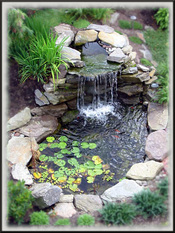
A large number of pond owners are misconceived when it comes to the presence of algae in aquatic structures. The problem occurs where the algae is growing prolifically often distorting the color and the texture of the water. A poor quality of water can actually stress and stunt the growth of fish and therefore understanding ways of keeping your pond clean and fresh can create a balanced ecosystem.
Where the water quality is not maintained, ammonia levels will be on the rise impacting on the health of fish. In a large number of cases, it will result in poor gill function and an inability for the Koi to breathe. Apart from the devastating impact on fish, the presence of large amounts of algae can create an unattractive looking feature.
It is important to implement methods that will keep the correct balance of both algae and bacteria so that a healthy ecosystem is maintained. Where matter and waste are allowed to collect in the bottom of the pond, the oxygen content eventually decreases, which means that beneficial bacteria or microorganisms are unable to control for high levels of ammonia and nitrites. Even the application of a pump or filter to aerate the water will prove ineffective.
Increased exposure to sunlight during the warmer months creates the ideal conditions for algae growth. The key is to manage the amount of waste entering water in order to control ammonia and nitrite levels. The implementation of aquatic bacteria to break down the high organic content safely and naturally can prove most successful.
Be sure to avoid placing large number of aquatic plants, twigs, branches and similar objects in the water as this will breakdown over time increasing the nutrient rich content in the pond. With effective microorganisms and aeration systems in place the bacteria will begin to eat the extra nutrients and muck settling in the bottom of ponds for clearer water. Where you are able to reposition plants to provide shade and clean out filters, it may give the beneficial bacteria an opportunity to repopulate.
There are many products available to add the necessary microorganisms to the pond. Once these have been added it will work to decrease ammonia and nitrates and increase the overall oxygen content. The result is a drastic reduction in the presence of algae as all organic content is broken down without any harm to the fish present in the water.
Should the water turn a brown color, clear the area of all debris and leaf matter that may have fallen into the pond and settled on the bottom. The addition of suitable microorganisms will allow for acceleration in the break down of any remaining leaf or organic matter. Over time you will also notice the water beginning to clear and reduce the collection of sediment.
To keep your pond looking clean, fresh and have no algae present with beneficial microorganisms it is important to exercise regular maintenance. This includes cleaning filters, checking aeration systems and introducing beneficial bacteria. This will enhance the desired microorganism populations and the breakdown of excess waste.
Controlling Algae Naturally in Your Pond
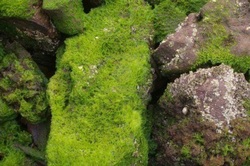 By Clifford Woods
You have two choices in dealing with algae in your pond and that is with chemicals or naturally.
Chemical methods are fine if you there are no living creatures or plants in your pond because algaecide and chemicals will kill any and all life in the water. Normally chemicals would be used in a swimming pool or perhaps outdoor fountains, any water feature that does not have plants and or fish in them.
The natural way works with Mother Nature, not against her. You could use plants and fish, or good bacteria that would create and maintain a healthy well balanced ecosystem.
Algae itself is a plant, it needs nutrients and light to grow so when you add plants to your pond they directly compete for the nutrients available. Add enough plants and you naturally minimize the nutrients available to the algae.- Over feeding your fish. Fish food that is not digested by the fish is the main pollutant in many ponds. Fish eat many things in the pond and that includes algae. Too much food for the fish increases waste and provides nutrients that feed the algae. When the algae goes on an over population bloom reduce or eliminate feeding until it is under control.
- Reduce sunlight penetration: Cover at least half of the surface area of your pond with plants. Water that is not covered is much more difficult to keep in balance than ponds filled with healthy plants.
- Add bacteria: healthy colonies of beneficial bacteria are a crucial part in ensuring a naturally balanced pond. When cooler water temperatures are present add more and during the warmer months add less.
- Keep the water moving: pulling water from one end of the pond and then filtering it before it returns at the opposite end will greatly improve water quality. Oxygen is added to the water as it is circulated.
- Water run-off from lawns and surrounding gardens can overload the pond with nutrients and that is not good for the life in your pond. Create a run off or add a drain tile.
- Decaying leaves and or plant debris will also create excess nutrients in your pond. You must manually take out the dead and decaying plants and their leaves. Skimmer are by far the most efficient and easiest way to keep your pond free of debris.
- Water change: A partial water change (10-30%) every month or month and a half may also help reduce excess nutrients in some situations.
|















 RSS Feed
RSS Feed